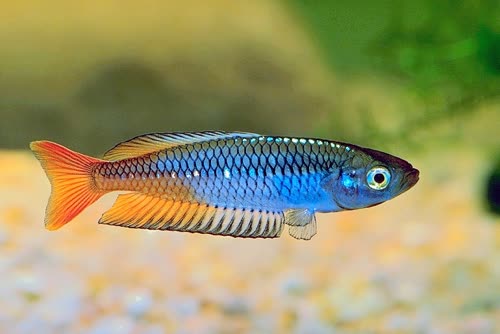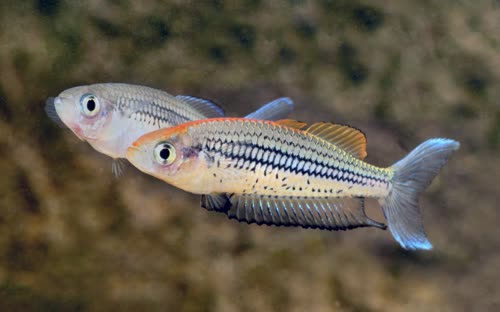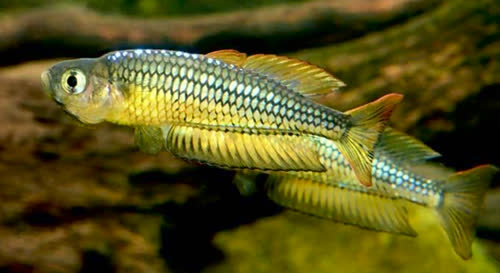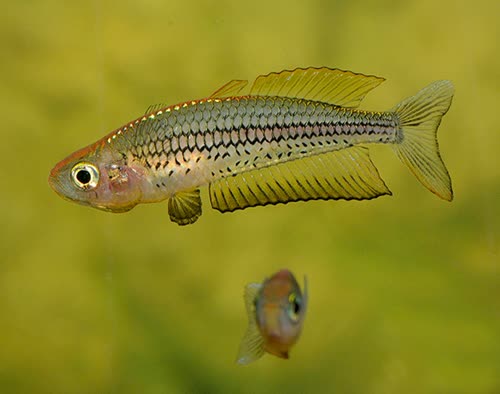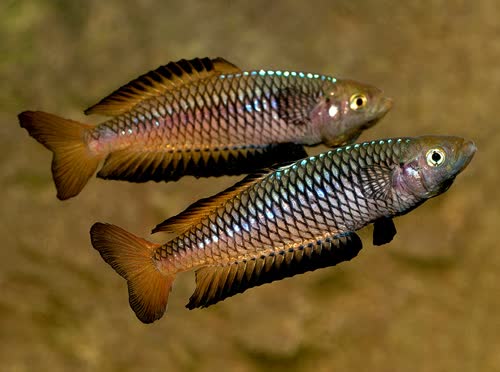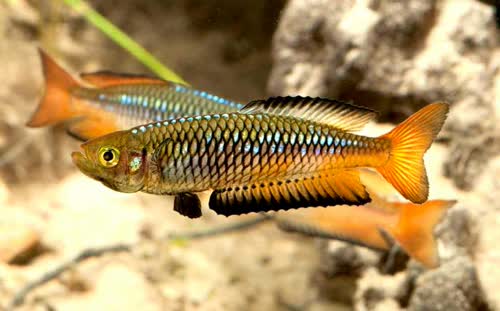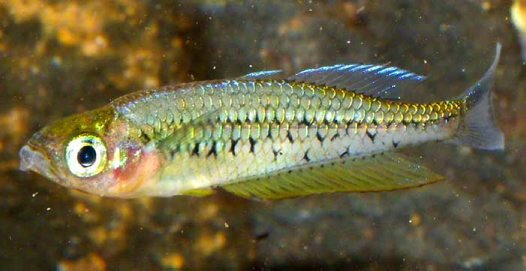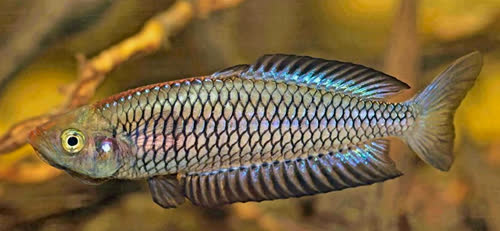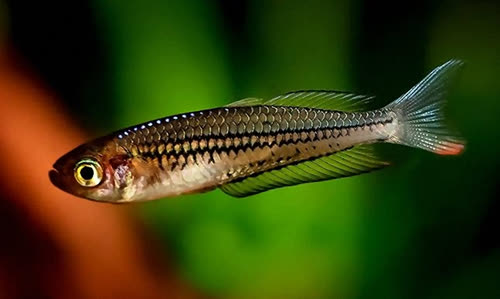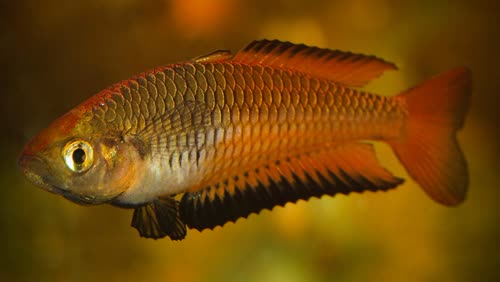In Australia four distinct populations of ornate rainbowfish have been identified to date. The four populations occur from Byfield to Fraser Island, Cooloola, Noosa River to Brunswick Heads and south of Brunswick Heads to Nambucca. These populations diverged between two and seven million years ago and so represent long-term divisions and should be considered separate for conservation purposes.
(Page, T.J., Sharma, S. and Hughes, J.M. (2004). Deep phylogenetic structure has conservation implications for ornate rainbowfish (Melanotaeniidae: Rhadinocentrus ornatus) in Queensland, eastern Australia. Marine and Freshwater Research 55, 165–172.)
"It seems every creek system has its own unique population - they certainly vary in colour and potentially could be quite distinct genetically. Ornate rainbowfish can grow to a maximum size of around 7-8 cm in total length, but are usually more common at around 5-6 cm."
-
Wildlife Preservation Society of Queensland
This variation in the color (not as much, color
pattern ranges from almost completely blue to almost completely red fish. In addition, one finds the coloring variants mixed together in Same Creek. -
Rainbow's World
A 1924 survey of Moreton Island, noted that Rhadinocentrus ornatus were found in swamps and unnamed streams south of the lighthouse. The first report of R. ornatus being found on the mainland that I can find was in an Aquarium & Terrarium Society of Queensland excursion report in 1927. At that time they were known only from Moreton Island. They were found in Belmont (Bulimba Creek), an outer southside suburb of Brisbane. Later that same year they were reportedly found in the Pimpama River catchment (Pimpama Island) on the Gold Coast in southeast Queensland. Members of the Aquarium & Terrarium Society were also the first to discover R. ornatus on Stradbroke Island. They were found in "a little freshwater creek a few miles north of Myora". A description of the creek from the secretary, Amandus Rudel, in 1930 follows:
"The water in this particular creek is very soft and of a slightly brownish colour. Except for a slimy sort of algae, the creek has no under-water plants of any description. No snails or other small insects were to be found and how Rhadinocentrus gets a living is rather a puzzle. The creek is rather narrow but very deep in places and winds its way through a very flat piece of country on the Island. It's really more of a bog and one never knows when the ground gives way. Ferns and sphagnum moss grows all over the flat. Tracks of Kangaroos and Wallabies lead to the creek from all directions, and take it all around it's a very interesting piece of nature." - The Rainbowfish Site.
Literature
Aquarium and Terrarium Society of Queensland Archives 1926 - 1938.
Arthington A.H., M. Kennard and G.J. Miller (1990) Water quality and trophic status of Fraser Island lakes. Final report, Part A. Division of Environment, Queensland Department of Environment and Heritage.
Arthington A.H. and C.J. Marshall (1999) Diet of the Exotic Mosquitofish, Gambusia holbrooki, in an Australian Lake and Potential for Competition with Indigenous Fish Species. Asian Fisheries Science 12:1-16.
Coaldrake J.E. (1961) The ecosystem of the coastal lowlands ("wallum") of southeast Queensland. Bulletin 283 (CSIRO: Melbourne).
Coaldrake J. E. (1962) The coastal sand dunes of southern Queensland. Proceedings of the Royal Society of Queensland 72: 101-115.
Hancox D., C.J. Hoskin and R.S. Wilson (2010) Evening up the score: sexual selection favours both alternatives in the colour-polymorphic ornate rainbowfish. Animal Behaviour 80: 845-851.
Hancox D., R.S. Wilson and C.R. White (2013) Visual habitat geometry predicts relative morph abundance in the colour-polymorphic ornate rainbowfish. Proceedings of the Royal Society B: Biological Sciences, 280: 1-7.
Marshall J.C. (1988) An extension of the known range of Rhadinocentrus ornatus. Fishes of Sahul 5: 196-197.
Mather A., D. Hancox and C. Riginos (2015) Urban development explains reduced genetic diversity in a narrow range endemic freshwater fish. Conservation Genetics 16: 625-634.
McKay R. & J. Johnson (1990) The freshwater and estuarine fishes, In: The Brisbane River: A source book for the future, Davie P, Stock EC and Choy DL (Eds), pp 153-168, Australian Littoral Society, Brisbane, Australia.
Page T.J., S. Sharma and J.M. Hughes (2004) Deep phylogenetic structure has conservation implications for ornate rainbowfish (Melanotaeniidae: Rhadinocentrus ornatus) in Queensland, eastern Australia. Marine and Freshwater Research 55: 165-172.
Page T.J. & J.M. Hughes (2007) Phylogeographic structure in an Australian freshwater shrimp largely pre-dates the geological origins of its landscape. Heredity 98: 222-231.
Pusey B.J., M.J. Kennard and A.H. Arthington (2004) Freshwater Fishes of North-Eastern Australia. CSIRO Publishing, Victoria.
Regan C.T. (1914) Report on the freshwater fishes collected by the British Ornithologists' Union expedition and the Wollaston expedition in Dutch New Guinea. Transactions of the Zoological Society of London: 275-286.
Sharma S. & J. M. Hughes (2011) Genetic structure and phylogeography of two freshwater fishes, Rhadinocentrus ornatus and Hypseleotris compressa, in southern Queensland, Australia, inferred from allozymes and mitochondrial DNA. Journal of Fish Biology 78: 57-77.

